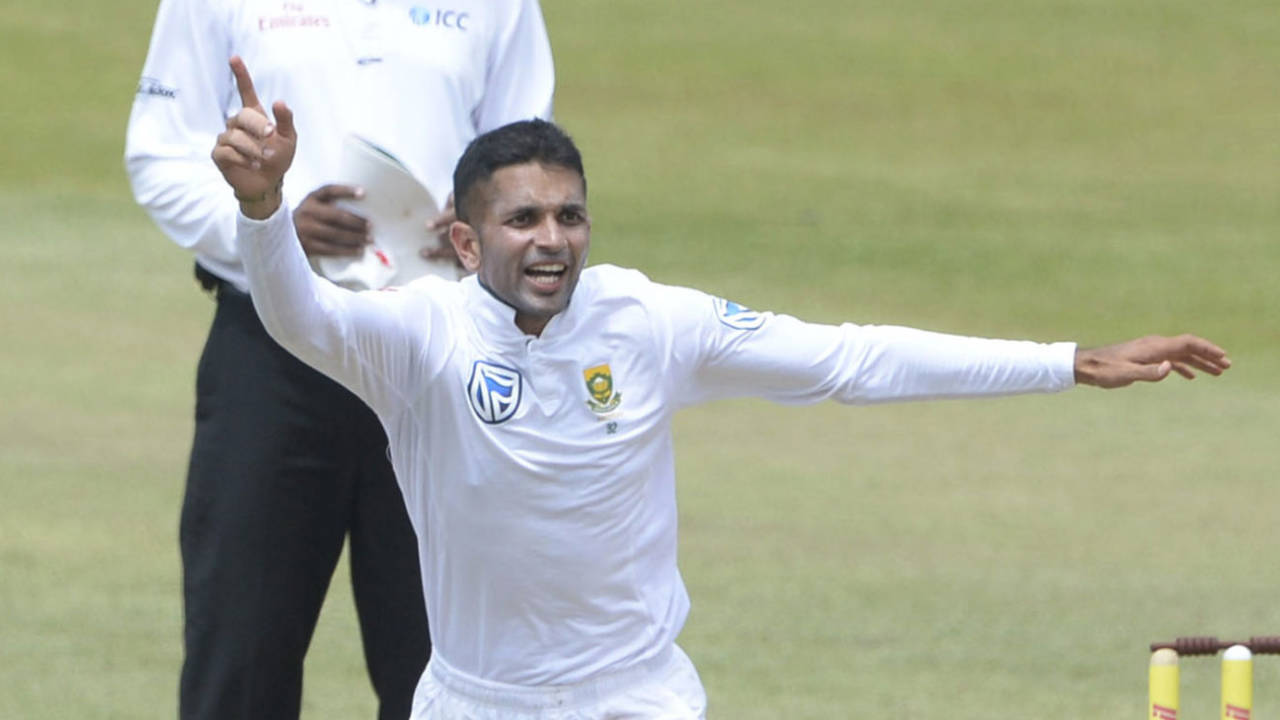Whisper it to
Keshav Maharaj: over the next three weeks, he is going to spend a lot of time in the spotlight.
An unassuming character, who deflects praise onto his team-mates even when he deserves it, Maharaj will have to become comfortable with being expected to stand out in Sri Lanka. He is South Africa's first-choice spinner, even though illness prevented him from bowling in the warm-up match in Colombo, and he is likely to be South Africa's only spinner in the series, even though they have taken three. Ottis Gibson
confirmed South Africa will stick with three seamers and a second spinner will only be included at the expense of a batsman if conditions demand it.
It's the perfect opportunity for Maharaj to really make a name for himself, on his first tour of the subcontinent, after 20 impressive Tests since debut.
Maharaj has taken wickets in New Zealand, in England, and at home, but has not had the chance to play on pitches specifically suited to him yet. Though Maharaj is not a particularly big turner of the ball, on Sri Lankan pitches, he may be able to operate in the unfamiliar role of strike bowler.
"Unlike in South Africa, as a spinner in the subcontinent, you become the main man, especially in the second innings. Everyone looks to you to bowl the side out and generally there's only one of you,"
Paul Harris, former left-arm spinner told ESPNcricinfo. "It's more of a mental battle, getting over the fact that you are the main guy and you have to be the one that does it."
Harris played only seven of his 37 Tests in the subcontinent, two in Pakistan and five in India, and was particularly prominent during their victory
in Karachi in 2007. Harris took a first-innings five-for, which gave South Africa a big lead, and ultimately a series-winning victory.
One of the things Harris learnt on that tour was that in spinner-friendly conditions, there is a danger of getting carried away. "Sometimes you try too many different things. You try and bowl sides out rather than sticking to the basics," Harris said.
"You don't need to strive to take wickets and bowl 10 overs, 6 for 30. That doesn't happen. Even if you look at Herath, at home, if often takes him 25 to 30 overs in the second innings to bowl a side out."
Paul Harris
Someone who was guilty of exactly that was the last spinner South Africa took to Sri Lanka:
Imran Tahir. The legspinner was on the 2014 tour and only played five Tests (four in India) after that series. His performances on the island may explain why Tahir's Test career never really kicked off.
In Galle, Tahir was economical in the first innings for his sole scalp and went wicketless in the second, a stat made worse by the fact that JP Duminy's part-time offspin claimed two scalps, including that of Kumar Sangakkara.
In Colombo, where Rangana Herath almost bowled Sri Lanka to victory, Tahir's workload was the highest among the South African bowlers but again, he was the least successful. He bowled 33 first-innings overs with a return of 1 for 121 (Duminy took 2 for 80 in 18 overs) and 18 second-innings overs, taking 2 for 76. In the end, three of the top five wicket-takers were spinners and Tahir was not one of them. Duminy was.
Despite all the hype about the added dimension Tahir could bring to a South African attack that relied on pace, he played just 20 Tests and took 57 wickets in his 20 Tests at 40.24, a complete contrast to his first-class record of 784 wickets at 26.63. By contrast, Maharaj has taken 74 wickets in 20 Tests at 28.36. The difference has been put down to Tahir's desperation to impress, which resulted in him bowling his full repertoire of deliveries, often without maintaining the discipline or consistency needed to create pressure.
"If the wicket is turning, you don't need too many variations, you don't need to change much up. You just need to land the ball in the right area. The wicket will do the rest for you," Harris said. "You don't need to strive to take wickets and bowl 10 overs, 6 for 30. That doesn't happen. Even if you look at Herath, at home, if often takes him 25 to 30 overs in the second innings to bowl a side out. All he does is he mixes up his flight and his pace and hits the same area over and over and over again."
A glance at
Herath's record proves Harris correct. Herath bowled 39.1 overs in the second innings of his most recent home match against Zimbabwe, where he took 6 for 133. Before that, he bowled 20.2 overs to take 6 for 59 against Bangladesh, and 18.1 overs to take 7 for 64 in dismissing Australia in Colombo.
Whether Maharaj will be able to produce results that are as emphatic remains to be seen, but Harris hopes he doesn't focus purely on attacking and remembers his ability to contain, against players who are adept at playing spin. "The usual things are that you've got to be pretty accurate because those guys can play spin," Harris said. "It's going to be a mental shift for Keshav, and he has to not try and bowl a side out. He has been phenomenal in South Africa and he gets five-fors, but he does that by being consistent and hitting the right areas. He needs to do that in Sri Lanka too, even when he becomes the main man, especially in the second innings."

